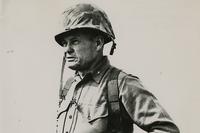As humans go through their daily lives, their perception of where they are in relation to everything around them, including the earth, is constantly updated by what they can see, feel and hear.
This constant update of information is part of what allows us to move through the world without even thinking about the effort. In a high-speed aircraft flying in a three-dimensional environment, sometimes at night and in thick cloud cover, these updates can feel definitive even when they're inaccurate.
Pilots can actually lose the ability to determine their true body position, motion and altitude relative to the earth or even what's around them while in flight, a condition known as spatial disorientation. It can cause a pilot to think they're flying upright and level, even when they aren't.
It's a big issue and always has been, but only relatively recently has the perception of it changed. Once considered a pilot's personal failing, the U.S. military has had to develop a means of keeping pilots oriented, and for good reason. It can take pilots up to 30 seconds to reorient themselves, a long time while behind the stick of a jet aircraft.
The estimated damages caused by spatial disorientation cost the U.S. military an estimated $300 million every year, along with the lives of around 30 pilots.
To combat the dangers, Dr. Angus Rupert, then a flight surgeon at the Naval Aerospace Medical Research Laboratory and later the U.S. Army Aeromedical Research Laboratory, created the Tactile Situational Awareness System (TSAS), a vest that turns what a pilot can't see into tactile signals a pilot can feel. Later, even NASA would help develop the technology.
It was an idea that required a lot of unorthodox thinking and experimentation.
In 1974, the future Dr. Rupert was skydiving naked while he was a student at the University of Illinois. He noticed that the rush of air on so much bare skin kept him oriented, even as he spun and twirled in midair.
He considered how increased tactile sensations might be useful for pilots in mid-flight. Years later, with a Ph.D. in neurophysiology and a medical degree, Rupert signed on at the aerospace medical lab and has focused on disorientation ever since.
Rupert's first prototype used a 69-cent toy to provide the necessary tactile stimulation to reorient a pilot. More than 30 years later, vibrations are the main indicators.
The TSAS vest was developed for fixed-wing and rotary pilots to use the vibrations to inform the pilot about aircraft pitch, roll, airspeed and heading information, acquired from flight instruments. For example, if a pilot banks too far to the left, the vest vibrates on the left; too far to the right will cause a vibration on the vest's right side.
TSAS keeps pilots so well-oriented that they are able to fly an aircraft upside down while blindfolded and still maintain their spatial orientation. Rupert tested the vest while flying a Stearman biplane upside down with his vision impaired, as did many other pilots in his 1999 series of flight tests.

That series of tests not only kept the pilots oriented in the air, it actually improved their situational awareness while decreasing their workload, even as the researchers purposely inhibited their ability to see visual cues and tried to disorient them.
Today, Rupert is a senior research development scientist at Embry-Riddle Aeronautical University in Florida. Although the development of the vest has been decades in the making, research on spatial disorientation continues. Current efforts include enlarging the vest to be able to include pitch and roll information for helicopter pilots.
-- Blake Stilwell can be reached at blake.stilwell@military.com. He can also be found on Twitter @blakestilwell or on Facebook.
Want to Learn More About Military Life?
Whether you're thinking of joining the military, looking for post-military careers or keeping up with military life and benefits, Military.com has you covered. Subscribe to Military.com to have military news, updates and resources delivered directly to your inbox.















